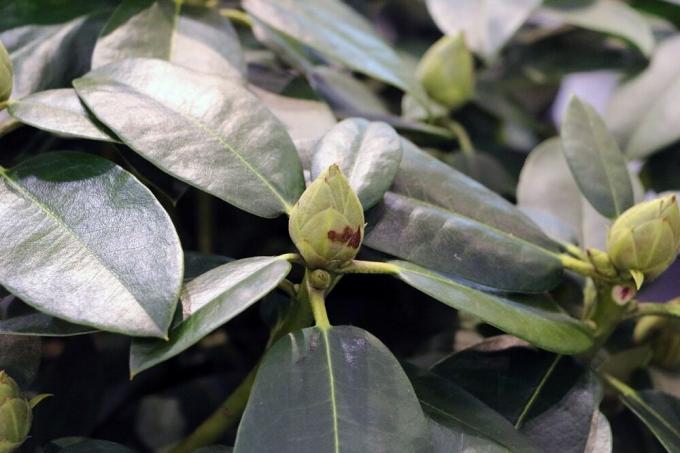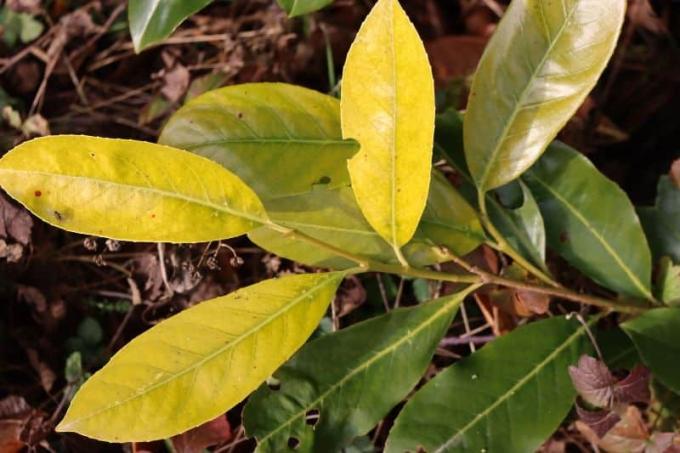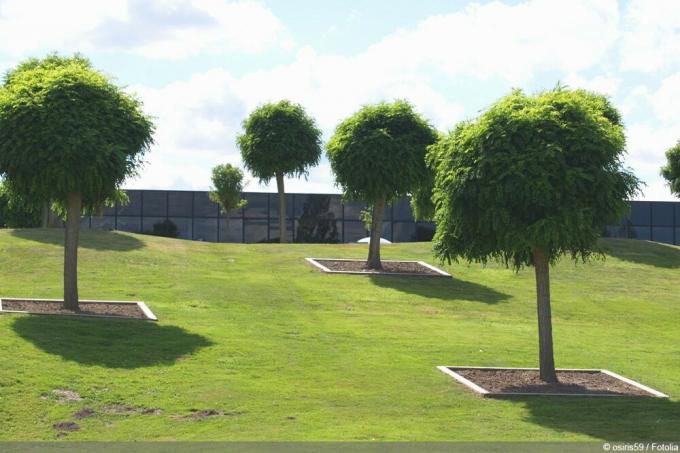

Table of contents
- rose tree
- planting time
- Location
- Floor
- planting
- Care
- wintering
- diseases and pests
Opinions often differ when it comes to rhododendrons. Some love the plant passionately, others can no longer see it. There are of course reasons for this: the rhododendron is probably the most widespread flowering shrub in our gardens. It goes without saying that you can get tired of the plant. On the other hand, hardly any other plant has such a lush variety of flowers.
rose tree
The term rhododendron comes from ancient Greek and means rose tree. The name refers to the enormous variety of flowers that is the defining feature of this plant genus. There are more than 1,100 rhododendron species worldwide. The main distribution area is Asia. A total of ten native species can be found in Europe. From a botanical point of view, they all belong to the woody plants. They are also shallow rooters. Rhododendrons are also one of the most popular garden plants. In the year 2000, German tree nurseries alone produced and sold around 20 million rhododendrons. This puts the ornamental shrub in a league with the rose, which enjoys a similar level of popularity.
planting time
If you want to have fun with rhododendrons in your garden, you should be extremely careful when planting them and be guided by the needs of the plant. In fact, this is where most mistakes are made – mistakes that are then difficult to correct. In principle, rhododendrons can always be planted outside of the frost period. The periods from the beginning of September to mid-November (autumn planting) and from the beginning of March to mid-May (spring planting) are ideal for this. Autumn planting is generally recommended. It has the great advantage that new roots are formed more quickly. In addition to the right time, the location and the soil conditions play a decisive role in the thriving of rhododendrons.
Location

The natural environment of rhododendrons in the wild are light forests. It follows that the plant likes partial shade and this fact must be taken into account when choosing the location. Under no circumstances should it be directly exposed to the blazing midday sun. On the other hand, the location should not be too shady either. Rhododendrons need a lot of light in order to be able to develop their flowers. If it is missing, the number of flowers will be rather puny. The combination in the garden with a so-called shade tree such as the Scots pine is ideal. It provides shade with its fine needles, but still lets enough sunlight through. In terms of root development and nutrition, the Scots pine does not compete with the rhododendrons.
Floor
As already mentioned, rhododendrons are flat-rooted. A loose soil that is as rich in humus as possible is therefore a must. Soils that are heavily infused with clay are basically not suitable for rhododendrons, as the fine roots of the plant cannot spread out in them. Although the location in the garden is suitable, the soil is too loamy or not loose enough should it be replaced. To do this, dig a hole about 50 cm deep with a diameter of about 150 cm for each plant. It is then filled again with a mixture consisting of equal parts bark compost and sand. Incidentally, we also recommend a layer of coarse sand or fine pebbles, which ensures better water drainage and thus helps to avoid waterlogging. If, on the other hand, the soil is already relatively loose and sandy, bark mulch and cattle manure should be worked in before planting.
planting
Rhododendrons that are purchased in specialist shops are usually available in a planter or with a bare root ball. Before planting, we first dig a hollow into which the root ball fits. However, the hollow should not be too deep. It is recommended that the top edge of the bale is roughly level with the ground surface.
Tip:
It is generally better to plant rhododendrons too high than too low. Planting too deep can lead to a lack of oxygen supply and thus to the death of the sensitive root system.
Once the bale is placed in the trough, a mixture of excavated soil and humus is loosely distributed around it in a one-to-one ratio. Then you step on the earth very little and very carefully before pouring it on well. Immediate fertilization with about two handfuls of horn shavings and a layer of bark mulch about five centimeters thick are also recommended. The latter reduces the risk of the soil drying out too quickly. If several rhododendrons are planted at the same time, certain distances must be observed. In principle, a minimum distance of 50 cm must be maintained. In the case of particularly large species, this is around 100 cm.
Care

When caring for rhododendrons, watering, fertilizing and cutting play a particularly important role. Basically, the plant is relatively easy to care for. For example, a cut is not absolutely necessary.
Pour
Rhododendrons should only be watered with rainwater - unless tap water is extremely low in lime. When watering, you should always make sure that the soil is moist but not too wet. It is important to avoid waterlogging under all circumstances. It is advisable to regularly check the moisture in the soil around the plant and to water it if necessary.
Fertilize
For rhododendrons to thrive, it is inevitable that they are fertilized regularly. Fertilization is best done in early spring. This provides the plants with enough nutrients to develop a lush green and as many buds as possible. Fine horn shavings or an organic fertilizer for rhododendrons are suitable as fertilizer. Both are simply spread in the root area.
A notice:
If the plant has been mulched, the mulch layer must be removed before fertilizing and then applied again.
Cut
As already mentioned, snowing the rhododendron plant is not absolutely necessary. However, withered flowers should be removed with a sharp knife or secateurs. Anyone who, for whatever reason, decides on a topiary or a strong pruning must absolutely make sure that the plant is really well rooted. Otherwise there is a risk that it will no longer sprout properly in the coming spring. If in doubt, it is better to avoid a hard cut and, if necessary, only remove dead wood. The best time for pruning is autumn.
wintering

Rhododendrons, which are native to us and grow, are hardy. However, it can happen that evergreen species are affected by cold winds and too much winter sun. In a particularly cold winter, it is therefore advisable to wrap the entire plant under fleece as a precaution. That way you are definitely on the safe side. In principle, however, rhododendrons can also remain outdoors and in the ground during the rust period.
diseases and pests
The most common disease in rhododendrons is what is known as dieback. As the name suggests, it causes certain shoots to die off. In extreme cases, the entire plant can be affected. Most often, the cause of the disease is waterlogging. It is therefore best to fight them by stopping watering or checked the floor. If in doubt, the floor must be replaced or drainage installed to improve water drainage. When it comes to pests, the rhododendron cicada in particular can quickly become a major problem. She prefers to lay her eggs in the flower buds. In the process, a certain fungus is transmitted, which inevitably leads to the death of the buds. The best way to combat the rhododendron cicada is with special products from specialist retailers.
 garden editorial
garden editorial I write about everything that interests me in my garden.
Learn more about shrubs

Cherry laurel has yellow / brown leaves: what to do?
Cherry laurel is one of the hardy garden plants in the garden. Nevertheless, it can happen that the leaves of the cherry laurel turn yellow or brown. The causes are manifold. Since some can kill the cherry laurel, you should investigate.

12 native evergreen shrubs & woody plants
Dreary, bare trees and bushes in winter? It doesn't have to be. Even in the European climatic conditions, native, evergreen trees thrive splendidly. The variety of species even enables the gardener to adapt his privacy hedge exactly to his garden design. This guide presents the most beautiful native and evergreen shrubs and woody plants.

Curb Vinegar | Does bucket or root barrier help?
Vinegar trees like to spread in the garden and sometimes even drive other plants away. However, this can be avoided by curbing the growth of the trees. You can find out which methods are best suited for this here!

Rhododendron has dried up: how to save it | Rododendron
Even if the rhododendron is withered and no longer sprout, it does not have to be dead. The plant can look completely dried up above ground, but there is often still life in the roots. It is therefore worth taking appropriate measures to save the flowering shrub.

Winter jasmine, Jasminum nudiflorum | Care, propagation & pruning
The winter jasmine is a relatively frugal and robust plant that can cope with many different site conditions. The plant enchants with bright yellow flowers in winter and tolerates deep sub-zero temperatures very well. It should be pruned regularly and is easy to propagate.

Ball Tree: Care from A – Z | These 9 varieties are suitable for ball trees
Ball trees adorn many a garden, front yard and entrance area. They require little space. Their trunk thickens with age, but its height remains the same. The spherical crown is easy to trim. Nevertheless, they offer everything that makes a tree.
